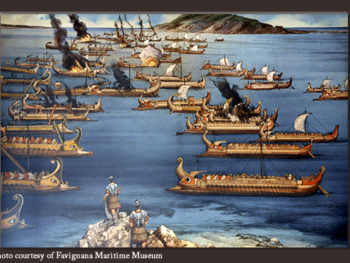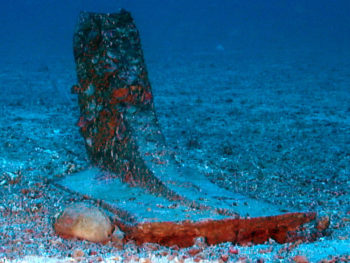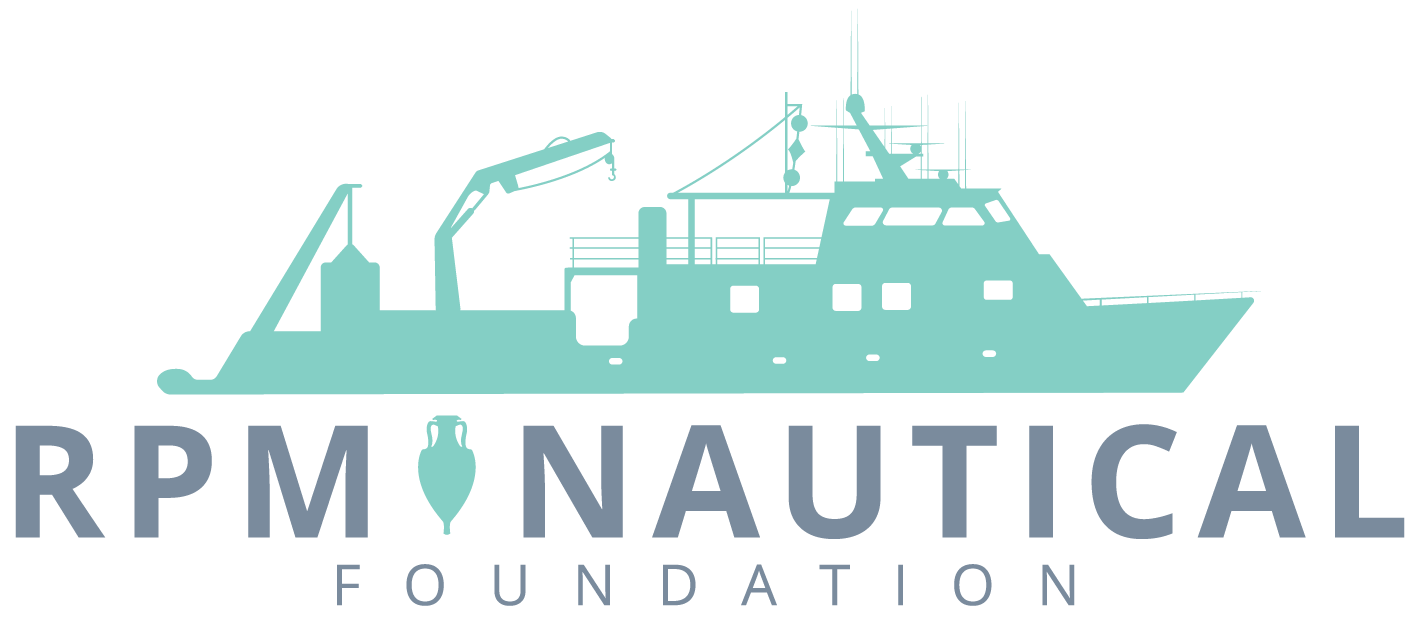The extensive wrecksite of a Roman merchantman originating in North Africa found near the Egadi islands
Egadi 11 Ram
Ancient warship ram from the First Punic War found off the Egadi islands

Project Location: Sicily, Italy
Project Duration: 2005-present
The Classical era in the Mediterranean saw a tumultuous naval history, with the epic clashes of ancient warships. Though the seabed should be littered with the remains of these naval battles, as of 2005 no one had been able to locate a single archaeological site that marked the resting places of the thousands of warships lost in classical era naval battles. In fact, only two warship rams had ever been found, both by happenstance – the now famous Athlit ram and another that was snagged in a fishing trawler’s net near Messina. Then, in 2001, Dr. Sebastiano Tusa – the driving force behind nautical archaeology in Sicily, learned of a ram that was on display in the offices of a dentist in Trapani, the Sicilian city nearest to the offshore Egadi Islands. The ram was promptly seized by Italian authorities, who learned that it had been pulled up by Italian fishermen near the Egadi Islands. This location is believed to be the site of a pivotal naval battle, which marked the Roman Republic’s victory over Carthage in the First Punic War in 241 BCE. The most reliable accounts of the battle come from the ancient historian, Polybius, who detailed the results of Rome’s decisive victory: 50 Carthaginian ships sunk, 80 vessels captured, nearly ten thousand prisoners taken.
The waters around the Egadi Islands, one of antiquity’s great trade routes between Tunisia and Rome, had considerable potential to contain archaeological remains from the Battle of the Egadi Islands. The area that needed to be surveyed was approximately the size of the city of Manhattan. What seemed like an insurmountable task led to a partnership between RPM Nautical Foundation and the Soprintendenza del Mare, Regione Siciliana – Dr. Sebastiano Tusa. Dr. Tusa, became Assessore of the Sicilian Ministry of Culture Heritage in 2017 and remained Co-Director of the project.
Tragically, Dr. Tusa fell victim in March 2019 to an airplane crash while traveling to a UNESCO meeting. He remains profoundly mourned and missed.
The project team expanded in 2017 with the addition of Mario Arena, Francesco Spaggiari and their team of Society for the Documentation of Submerged Sites (SDSS) divers, highly trained and skilled technical divers who have expanded the project’s survey capabilities, and excavated sensitive and fragile artifacts.
As of the end of the 2024 field season, 27 ancient warship rams have been added to the archaeological record, each of them marking a shipwreck whose wooden components have long since been lost to the harsh effects of salt water over time. For the first time, an ancient naval battle site had been discovered.
Read More In early 241 BCE, however, the tide turned in Rome’s favor. From 249 BCE to February 241 BCE, the Roman and Carthaginian land armies had fought to a stalemate at Mount Erice, near Trapani, and had each dug in for extended siege warfare. The Carthaginian army depended on supplies brought by sea, which meant their ships had to pass close by the Egadi Islands. The Roman Republic had embarked on a crash shipbuilding program to replace their losses from previous battles with new warships. We now know that the Carthaginians had continued to use hulls captured from the Romans over the previous decade. This meant that the Carthaginian warships were no longer in peak condition. The Romans also had the great advantage of knowing exactly where the Carthaginian ships had to go if they were to succeed in resupplying their army. On March 9, 241 BCE, a Carthaginian fleet of more than 200 warships and transports reached Marettimo, the westernmost of the Egadi Islands. The Roman Navy hid to the east of Levanzo, out of sight of the Carthaginians. At first light on March 10, 241 BCE, the Carthaginian navy sailed from Marettimo, heavily laden with supplies that they intended to unload for their army, then search out the Roman Navy unencumbered by cargo. The Roman Navy lookouts saw the Carthaginian ships and the Romans moved rapidly into a blocking position. The Roman ships won decisively. According to Greek historian Polybius, at least 50 Carthaginian ships sunk and nearly 10,000 Carthaginians were taken prisoner. Critically, the Carthaginians were unable to land the desperately needed supplies, and stay current on the cash payroll for their mercenaries. The RPM-Soprintendenza del Mare/SDSS investigation of the area has thus far produced findings consistent with the ancient accounts. At locations consistent with the Roman Navy intercepting and blocking a Carthaginian fleet headed for Mount Erice, we have found at least two areas where groups of warships collided, rams were damaged by head-on collisions, and warships sank, with bronze helmets sitting on the seabed as testimony to the loss of life. The historical accounts agree that the Carthaginian ships that were not captured or sunk turned back without reaching their army and the seabed in the battle areas discovered to date is littered with scattered amphorae that appear to have been jettisoned either heading into battle or fleeing from the defeat. The historical accounts also agree that Carthage had no choice but to sue for peace and pay Rome an enormous indemnity in return for safe passage for its marooned army. The financial handcuffs Rome imposed on Carthage succeeded in bringing peace about, but as it turned out, only until 218 BCE, when the Second Punic War began. The conflict ended only in 146 BCE, with the Third Punic War at the end of which Rome razed Carthage to the ground and enslaved or killed all of its people.> Read Less
The First Punic War (264 to 241 BCE) was the longest continuous conflict and greatest naval war of antiquity; it was the first of three wars fought over more than a century by the two major powers in the Mediterranean – the Roman Republic and Ancient Carthage, whose empire included Iberian peninsula, Corsica, Sardinia, Sicily, and North Africa. From 264 BCE until the final Battle of the Egadi Islands, the Carthaginian Navy won nearly one of a series of naval battles, all of which took place in Sicilian waters.
Read More RPM’s search for the site of the Egadi Islands naval battle began in 2005 on board R/V Hercules, using multibeam sonar, sidescan sonar, ROV, and AUV technologies. However, remote sensing efforts have been frustrated at times by the large portions of rocky seabed, which impedes our view of the seafloor. Through the use of ROV video in conjunction with remote sensing techniques, we have greatly expanded the reliability of the data. Despite high hopes and the team’s persistence, the first three years of survey were largely fruitless. Most of the notable finds were upper portions of Greco-Italic amphoras. With the exception of finding the Levanzo I site, a late 3rd to early 4th century CE merchantman, the RPM team remained unsuccessful in finding any remains of the Egadi Islands naval battle. It wasn’t until 2008 that the first ancient warship ram was found – the first ever to be recovered by archaeologists – which provided early hopes that the battle site had been found. However, it took nearly four more years of surveying before the team was confident they had discovered the ancient naval battle site. Progress was rapidly made; during survey seasons in 2010-2011, the outlines of the first major cluster of battle remains were discovered in grid zones J13-14. Five additional rams were located, as well as the first clusters of bronze helmets. The pattern of the battle started taking shape, as RPM team members discovered several scattered mounds of amphoras that would have held supplies on board the warships. A grid was established that expanded the search area considerably further to the north and south than the original search locations. From 2012 through 2015, search continued in the J14 grid zone. Survey work in 2017-2018 eclipsed all previous seasons; 12 new rams were discovered, as well as large numbers of scattered Punic and Greco-Italic amphoras, providing definitive proof that the battle area extended to the southeast. We realized that the first search area was only one of a number of battle zones and likely constituted only the northern flank of the Carthaginian navy, who also held a larger concentration of forces to the south. 2017 brought a new partner to the project: The Society for the Documentation of Submerged Sites (SDSS). This highly trained group of specialized technical divers who have provided invaluable added capabilities to the project, including: raising fragile objects, using divers hands rather than rov manipulators, using handheld metal detectors, and visual diver surveys that complement our rov surveys. Several of the ancient rams have been excavated for further analysis and conservation.> Read Less

The extensive wrecksite of a Roman merchantman originating in North Africa found near the Egadi islands

The site of a major naval battle between Roman and Carthage during the First Punic War; the first ancient naval battlegrounds to be found by archaeologists

The site of a major naval battle between Roman and Carthage during the First Punic War; the first ancient naval battlegrounds to be found by archaeologists

Ancient warship ram from the First Punic War found off the Egadi islands

Possibly an ancient anchor stock dating to at least the 2nd century BCE found near the Egadi islands

Bronze helmets with a Celtic origin found at the site of the Battle of the Aegates

A mixture of ceramic artifacts discovered during ROV operations

A cargo of raw sulphur ore and some preserved wooden hull remains found near the Egadi islands

Ancient warship ram from the First Punic War found off the Egadi islands

Ancient warship ram from the First Punic War found off the Egadi islands

Ancient warship ram from the First Punic War found off the Egadi islands

Ancient warship ram from the First Punic War found off the Egadi islands

Ancient warship ram from the First Punic War found off the Egadi islands

Ancient warship ram from the First Punic War found off the Egadi islands

Ancient warship ram from the First Punic War found off the Egadi islands
